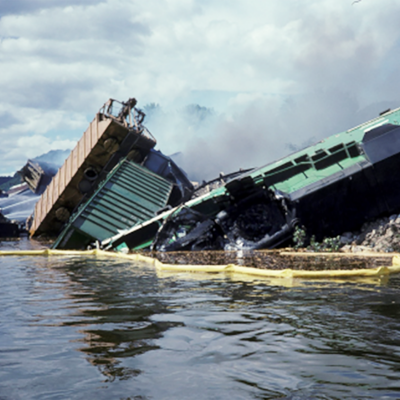Assessments of the River's Water Quality
Based on review of 19 water quality parameters grouped into four categories—nutrients, heavy metals, salts and pathogens, and physical — UMRBA's 2023 How Clean is the River? Report finds that water quality between 1989 and 2018 has generally improved, while there are pollutants of concern that have varying trends. Decreases in legacy heavy metals, sediment, and phosphorus, for example, show that public and private investments in managing water quality are beneficial and that the approaches taken have been effective. Nitrogen, chloride, and contemporary or emerging pollutants of concern, however, are rising and require a five-state approach to develop effective solutions.
The 2023 How Clean is the River? is UMRBA's second, collective effort to understand water quality trends in the basin, which includes Illinois, Iowa, Minnesota, Missouri, and Wisconsin. The first report was published in 1989 and led UMRBA to focus its work on heavy metals and sediment. The 2023 analysis includes water quality data from 1989 to 2018 and supports UMRBA’s current focus on nutrients and chloride.
UMRBA's How Clean is the River? water quality analyses underscore the value of coordinated and comprehensive water quality monitoring for the Basin. In combination with UMRBA’s Interstate Water Quality Monitoring Program, the report’s findings will allow the five Basin states to more effectively identify problem areas, target management actions, and measure progress in protecting water quality.
Water Quality Conditions from 1972 to 1986
Using USGS's National Water Quality Assessment datasets spanning 1972 to 1986, the 1989 How Clean is the River? report evaluated the Upper Mississippi River's water quality condition by exceedances of standards, support uses (i.e., national goals), quality of the fishery, sediment quality, and spatial and temporal trends. It found that 69 percent of the river (approximately 583 miles) has water quality problems, with the majority of those problems concentrated at the upstream and downstream ends of the river. Stretches of the river with the best water quality were between L&Ds 10 and 19 as well as L&Ds 20 and 21 – i.e., away from the major metropolitan areas and major tributaries (Minnesota, Illinois, and Missouri Rivers). The most pervasive water quality problem was the degradation of the fishery resource. This report set the course in subsequent years for UMRBA’s focus on sedimentation and toxic pollutants.
Water Quality Conditions from 1989 to 2018
The 2023 How Clean is the River? Report picks back up from the 1989 report in terms of the trend period, evaluating trends from 1989 to 2018 using water quality data collected by Minnesota Pollution Control Agency, Wisconsin DNR, and Illinois Environmental Protection Agency as well as the Upper Mississippi River Restoration Program’s long term resource monitoring and long-term continuous flow records from gages maintained by USGS and the USACE. The analysis uses flow-adjusted trend analyses, which allows for measuring the trends in concentration that are not simply correlated with river flows.
The 2023 results conclude that:
- Nutrients (Total Phosphorus, Total Nitrogen, Nitrate & Nitrite, Ammonia, Chlorophyll-a)
Although phosphorus reduction goals are yet to be met, phosphorus continues to decline in the Basin due to successes of the Clean Water Act. Ammonia, a fraction of total nitrogen, is also generally decreasing. Ammonia can be toxic to aquatic life.
These are important improvements in water quality because excess nutrients cause algae overgrowth, which can harm water quality, food resources, habitat, and decrease oxygen concentrations, all which have an effect on aquatic life and outdoor recreation opportunities.
Excess nutrients in the river originate from various sources, including agriculture, stormwater runoff, and wastewater. Achieving nutrient reductions requires a multifaceted approach.
Even with these successes, there are some concerns. Despite efforts to reduce nitrogen and phosphorus pollution to the Gulf of Mexico Hypoxic Zone, total nitrogen is increasing. Nitrogen originates from nonpoint sources, such as urban and agricultural runoff, or pollution runoff from a broad area. The Hypoxic Zone receives attention nationwide because of its low oxygen levels―conditions that are not suitable for aquatic life to survive. Local problems with excess nutrients cause the overgrowth of algae and result in diminished recreational opportunities.
- Heavy Metals (Aluminum, Arsenic, Lead, Zinc, Copper, Mercury, Cadmium)
Significant successes have resulted from implementation of pollution reduction efforts under the Clean Water Act. There has been a general decrease in heavy metals, which are both naturally occurring from underlying geology and human-made from manufacturing and industrial processes. Still, while well below the maximum contaminant level set by the federal Safe Drinking Water Act, lead is increasing in Pools 15 and 17 near the Quad Cities in Illinois and Iowa and New Boston, Illinois, respectively. The reasons for this are not completely understood and warrant investigation and research.
- Salts and Pathogens (Chloride, Sulfate, E. coli, Fecal Coliform)
Chloride increased at least 35 percent in the basin. The primary source is salt used to de-ice roads during winter. While road salt makes transit safer for people, too much of it is toxic to aquatic life that live in water bodies. Other dominant chloride sources include household water softeners and fertilizers.
- Physical (Temperature, Conductivity, Total Suspended Solids, pH, Turbidity, Dissolved Oxygen)
There have been decreases in total suspended solids of at least 40 percent across the basin. Turbidity and dissolved oxygen have also decreased. These reductions allow for light to reach aquatic vegetation, increasing its growth and thereby providing habitat and food for aquatic organisms.




